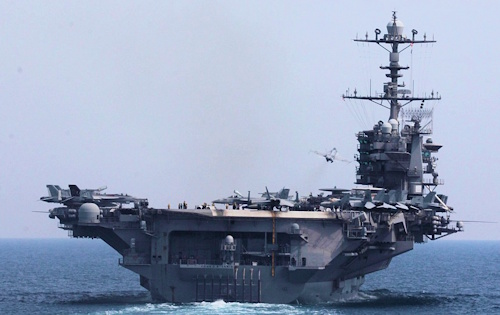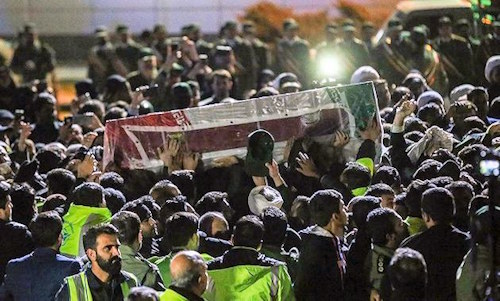Why all this hype about the US-Iran crisis? Most of the men and subsidies of international terrorism come from Saudi Arabia, from the fundamentalist Muslims of North Africa and from some countries of Eastern Europe that supply contractors. Contrary to what is thought, it is not Iran that fosters terrorism and not even Iraq. At most in the last two countries there is talk of patriotism.
Iran, through General Soleimani, took the field with men and means to help defeat the presence of ISIS on Iraqi-Syrian territory, given the known difficulties in which they were facing. The operation was substantially successful and this generated the catalyst for the general's influence in Iraq and beyond.
Following these events, Iran has experienced a steady growth in its influence and political-military presence in the area, because Tehran is always careful to hinder and stem the geopolitical influence expressed by the US, Saudi Arabia and Israel.
Given the overall picture overexposed, in the specific case of the attack on General Soleimani the origin of this action takes place over time. In 2017, intelligence, through CIA director Michael "Mike" Richard Pompeo, warned Qasem Soleimani against interfering with US interests in Iraq and internal affairs in Baghdad.
This warning was not heeded and subsequently Iran pursued more vigorously a policy of penetration of Iraqi internal power which allowed it to have political and military control. The general has gone so far as to be able to give his assent to the appointments of the top officials of the Iraqi government. Any activity, therefore, was examined by Soleimani, who gave consent or denial to the nominations of both Shiite and Sunni politicians. In this way the Iraqi politicians who aspired to power have come to terms with the general, thus ferrying the full sovereignty of Iraq to a limited sovereignty as controlled by Tehran.
The general, a skilled political weaver, has concentrated over time an enormous power in his hands. There is no doubt that his work was to cure Iran's interests and image.
 In mid-2019, America sent an aircraft carrier to the Persian Gulf. The purpose of this maneuver is still unclear, although some think it was a warning to Iran, while others think it was preparatory to the attack on Soleimani.
In mid-2019, America sent an aircraft carrier to the Persian Gulf. The purpose of this maneuver is still unclear, although some think it was a warning to Iran, while others think it was preparatory to the attack on Soleimani.
As a direct consequence of the presence of the aircraft carrier, on 25 October 2019 most of the Iraqi people, at the level of political geography of nine out of eighteen regions, spoke of their dissent to Iran and the return to full Iraqi sovereignty. This opposition turned into a political battle that led to a crackdown with around 650 dead. Dissent is still ongoing today.
Internal movements in Iraq, to restore political sovereignty, have generated interest and apprehension in some countries due to the risk of escalating instability. In this specific case the most worried would be the US and Israel. It is well known that the presence of Israeli intelligence is well rooted in the territory. Mossad is very active in the territories of the area. It could not be otherwise, seen and considered that the small state of Israel is having to carefully monitor every leaf that moves in order to avoid escalations that could affect the security of Tel Aviv.
This is the reason for the exceptional dynamism of the Mossad which of course does not move alone but exchanges information with its most powerful American ally: the CIA.
A typical procedure of Israeli foreign policy is to act with targeted operations trying to get the maximum political profit without starting a classic war. A prime example was the first Israeli airstrike in Iraq - during the Iraqi-Iranian war - destroying a German-built nuclear reactor in 1981.
 Why was Soleimani killed only now when he had been on the American blacklist for fifteen years?
Why was Soleimani killed only now when he had been on the American blacklist for fifteen years?
The most plausible answer, also corroborated by the thought of Iraqi public opinion, is that Soleimani had endorsed incautiously the attack on the US embassy in Baghdad. This operation would have put Soleimani beyond a point of no return. The red line has been crossed and the missiles have left.
America he could not, given the historical precedent, let it go and had to take decisive action to warn the whole Middle East. The day after the general's death, all countries dissociated themselves from the intervention authorized by Trump, except Israel and Italy only the former minister Salvini.
We do not enter into the merits of the lawfulness or otherwise of this operation, because it is a matter that each State sees differently and in this case facts are revealed.
There is an important detail about the attack: the blatant nature of the same. So why did we get to missile launches ...?! Soleimani was convinced that he had absolute control over the territory and local public opinion and evidently showed a great deal of confidence in his intelligence systems (human and technological): the only ones that could anticipate events. The proof of this is that he moved with a very small escort and without particular precautions.
With the two missiles, Trump has created a shock to Iran and above all to the intelligence and security structures, showing that it can strike whoever he wants, where he wants and when he wants. One of the possible reasons could be precisely this, because beyond the immediate reaction with the launch of missiles at military bases and the manifestation of dismay by a part of the Iraqi and Iranian people, the presence of millions of people in the his funeral and the immediate statements by the Iranian government on future actions towards the US, after a few days from Tehran, the tones softened, leaving openings for dialogue with the sworn enemy.
How is Italy viewed in this risk? It is absolutely not seen! Because in Iraq the people feel the political presence of France, Germany and England more.
The communications that circulate in the various media give increasing weight to the three countries mentioned. Italy hardly ever figures.
Dr. Khaleel Albazooni.
geopolitical, military analyst
Photo: US Army / US Navy / IRNA












